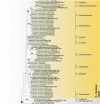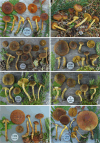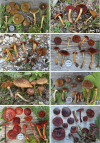Revised taxon definition in European Cortinarius subgenus Dermocybe based on phylogeny, chemotaxonomy, and morphology
- PMID: 38585620
- PMCID: PMC10997704
- DOI: 10.1007/s11557-024-01959-z
Revised taxon definition in European Cortinarius subgenus Dermocybe based on phylogeny, chemotaxonomy, and morphology
Abstract
Cortinarius (Fr.) Fr. is one of the most species-rich genera in the Agaricales (Basidiomycota). Cortinarius subgen. Dermocybe (Fr.) Trog includes brightly coloured Cortinarii with anthraquinone pigments. The chemotaxonomic approach has always been as important as classical methods for species definition of Dermocybe and helped to improve overall species concepts. However, some species concepts within this group remain unclear. We therefore address this topic based on a combined phylogenetic, morphological, and pigment-chemical approach. For this, sequence data, HPLC-MS pigment profiles and spore sizes were included were included to obtain a better resolution of taxa. The study was based on 173 recent collections and 12 type specimens. A total of 117 rDNA ITS sequences were produced from the collections in this study, 102 sequences were retrieved from databases. We could detect and clearly delimit 19 Dermocybe species occurring in central European habitats, from which 16 are discussed in detail. Additionally, we grouped the detected anthraquinone pigments into four groups. This detailed analysis of dermocyboid Cortinarius species occurring in a restricted number of habitat types confirmed our hypothesis that species diversity is much higher than currently assumed. This high diversity is blurred by too wide and incorrect species concepts of several classical species like C. croceus and C. cinnamomeus. Molecular and chemotaxonomical studies carried out together with careful phenotypical analyses resulted in a good differentiation of species. A key is presented for these taxa to allow a better identification of Cortinarius subgenus Dermocybe spp. occurring in Central Europe mainly in the alpine range.
Supplementary information: The online version contains supplementary material available at 10.1007/s11557-024-01959-z.
Keywords: Anthraquinone pigments; Central alpine range; Coniferous forests; Identification key; Integrative taxonomy.
© The Author(s) 2024.
Conflict of interest statement
Competing interestsThe authors declare that they have no competing interests.
Figures







References
-
- Arnold N, Besl H, Bresinsky A, Kemmer H (1987) Notizen zur Chemotaxonomie der Gattung "Dermocybe"(Agaricales) und zu ihrem Vorkommen in Bayern. Zeitschrift für Mykologie 53:187–194
-
- Bidaud A, Moënne-Loccoz P, Reumaux P, Henry R (1994) Atlas des Cortinaires. Pars VI. Éditions Fédération mycologique Dauphiné-Savoie, Marlioz
-
- da Silva AR, Malafaia G, Menezes IPP (2017) Biotools: An R function to predict spatial gene diversity via an individual-based approach. Gen Mol Res 16. 10.4238/gmr16029655 - PubMed
-
- Fellin A, Renato EE, Ferrari J (2020) Cortinarius holoxanthus dall’Italia settentrionale. Rivista micologica romana. Bollettino Dell’associazione Micologica Ecologica Romana 109:34–43
LinkOut - more resources
Full Text Sources
Miscellaneous
